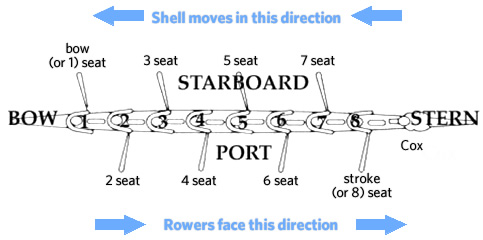Terminology
Catch
Moment of blade entry into water; immediate application of power.
Crew
Term used in American schools and colleges to designate the sport of rowing. When using the term crew, you should not use the term team, as it is redundant. Traditionally, crew means a team of rowers.
Ergometer
Rowers call it an "erg." It's a rowing machine that closely approximates the actual rowing motion. A popular choice is the Concept II, which utilizes a flywheel and a digital readout so that the rower can measure his "strokes per minute" and the distance covered.
Feathering
Rotating the oar in the oarlock with the inside hand so the blade is parallel to the water.
Finish
The final part of the stroke where the blade comes out of the water.
Leg Drive
Pushing the legs against the foot stretchers on the drive.
Power 10
A call for rowers to do 10 of their best, most powerful strokes. It's a strategy used to pull ahead of a competitor.
Puddles
Made when the blade is released from the water.
Release
Pushing down the handle to raise the blade out of the water at the end of the stroke to begin the recovery.
Recovery
The part of the stroke where the rower comes slowly up the slide to return to the catch.
Rowing
A general term that means rowing a boat with one oar per person or two oars per person. Rowing is used with the term team – Rowing team.
Rushing the Slide
Coming up the slide to the catch too fast causing one’s weight to be thrown toward the stern causing the boat to slow down.
Stroke Rate
Cadence of rowing; number count of cycles per minute.
Blade
The part of the oar that enters the water and captures the water resistance.
Bow
1. The forward section of the boat.
2. The first part of the boat to cross the finish line.
3. The person in the seat closest to the bow, who crosses the finish line first.
2. The first part of the boat to cross the finish line.
3. The person in the seat closest to the bow, who crosses the finish line first.
Bow coxed boat
A shell in which the coxswain is near the bow instead of the stern. It's hard to see the coxswain in this type of boat, because only his head is visible. Having the coxswain virtually lying down in the bow reduces wind resistance, and the weight distribution is better.
Cox Box
The electronic device combining a digital stroke rate monitor/elapsed time readout with a voice amplifier. The coxswain uses the cox box to manage the race and make their commands more audible to the crew.
Oar
Used to drive the boat forward: rowers do not use paddles.
Oarlock
U shaped plastic part in which the oar is placed.
Port
Left side of the boat, while facing forward, in the direction of the movement.
Rigger
The triangular shaped metal device that is bolted onto the side of the boat and holds the oars.
Sculls
One of the two disciplines of rowing - the one where each sculler uses two oars or sculls.
Shell
Can be used interchangeably with boat.
Slide
The set of runners for the wheels of each seat in the boat.
Starboard
Right side of the boat, while facing forward, in the direction of movement.
Stern
The rear of the boat; the direction the rowers are facing.
Stretcher or Foot-stretcher
Where the rower's feet go. The stretcher consists of two inclined footrests that hold the rower's shoes. The rower's shoes are bolted into the footrests.
Sweep
One of the two disciplines of rowing - the one where rowers use only one oar. Pairs (for two people), fours (for four people) and the eight are sweep boats. Pairs and fours may or may not have a coxswain. Eights always have a coxswain.
Coxswain
Person who steers the shell and is the on-the-water coach for the crew.
Seats

There are 8 rowing positions in a racing shell, plus the coxswain as follows:
- Seats 1 and 2: Referred to as Bow Pair. This pair focuses on “setting the boat”. Rowers in these positions typically have smooth and fluid technique.
- Seats 3, 4, 5 and 6: Referred to as the power or engine seats. Rowers in these positions are typically large and strong.
- Seats 7 and 8: Referred to as Stern Pair. They set the stroke rate for each side of the boat. Stern seats require fluid and consistent rowers. The 8 seat is also known as the Stroke.
- Coxswain: Person who steers the shell and is the on-the-water coach for the crew. The coxswain always faces the direction the shell is going where the rowers face the rear. Also called the “cox”.
- Stroke: The rower who sits closest to the stern. Stroke sets the rhythm for the boat; others behind must follow the cadence set.
Stroke
The rower who sits closest to the stern. The stroke sets the rhythm for the boat; others behind him must follow his or her cadence.
Head Race
A timed event of up to 5K meters with each crew starting in single file, with rolling starts at 10-20 second intervals. The start and finish times are recorded, the elapsed time calculated, and the fastest time wins. Typically held in the Fall Season with the Chargers and not part of the Spring High School season.
Regatta
An organized event where rowers gather to race.
Repechage
A "second-chance" race which ensures that everyone has two chances to advance from preliminary races since there is no seeding in the heats.
Sprint Races
1.5-2K meter races. The race course is divided into lanes and each lane is marked with buoys. All boats start the race in assigned lanes at the same time and race to the finish line. Typically held in the Spring Season.


